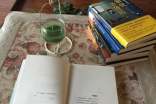1.worth, worthy 与worthwhile
worth价值,可贵之处,作形容词时与worthy和worthwhile都是“值得……”的意思,但用法不同,如:This book is worth reading./This book is worth 3 yuan?./It's wort hwhile to visit (visiting) this place./This place is worthy of a visit (visiting ).
worth只作表语,它后面一般接动名词,也可接名词,但只限于钱数,不接不定式。如果用不定式或动名词作主语,则要用It's worthwhile…结构,把不定式、动名词放在句末;
worthy是形容词,worthy可作表语,也可作定语,作表语时,后跟of接名词或动名词,也可以接不定式。
worthwhile和worth虽均有“值得的”意思,worth只作表语,用于be worth sth.短语中,如:It's worth the trouble.麻烦一点值得。This watch is worth this much money.这 块手表值这么多钱;而worthwhile意为“值得一做的(worth doing)”,既可作表语,如:T hese results were not worthwhile. 也可用作定语。
2.rise 与 raise
这两个词虽不同义,但因意义上有联系而易被混淆。rise 上升,上涨,起床,站立。含义较广,总的意思是指依次上升,如自然界的日、月、星、雾、云的上升,人体从睡、跪、坐、躺等姿势站立起来等。该词为不及物动词,其过去式与过去分词分别是rose 和 risen。例如:The sun rises in the east and sets in the west. 日出于东而落于西。/ Prices rise every day in those countries. 那些国家里的物价天天上涨。 /The chairman rose from his chair. 主席从椅子上站了起来。 raise 及物动词,其基本含义是“使升起来,举起”,它的过去分词和过去式都是raised。例如:Heavy rains raised the river. 暴雨使河水水位升高。/ We must raise the living standard of the people. 我们必须提高人民的生活水平。/ His speech raised my interest. 他的发言激起了我的兴趣。与raise 常搭配的固定说法有:raise a subject 提出一个问题 / raise one's voice 提高嗓门 / raise a family 养家糊口 / raise money 筹款/raise price 提高价格/ raise one's spirits 打起精神。
3.goal 与 aim
goal 目的,目标。常用于文学作品中,强调个人精心选定的目标,含有不达目的不罢休、与困难拼搏的意思,该词本身使人联想到参加赛跑的人,他们必须跑到终点。goal 也指赛跑的终点。如:He sticks stubbornly to his goal of education reform. 他不屈不挠地坚持他的奋斗目标——教育改革。/ His goal in life is to become a writer. 他一生的目标就是成为一个作家。 aim 目的,目标。呈单数形式时,指目标,但较 goal 具体、简单、近期,决心也稍弱。该词修辞色彩也较朴素。呈复数形式时,指笼统的理想与目标。如:What is your aim in working so hard? 你这样拼命工作,图的是什么? / She showed steadiness and courage in the pursuit of her aims. 她在追求自己的目标时表现出坚定性与勇气。
4.hurt injure harm 与 damage
1)hurt 普通用语,既可指肉体上的伤害,也可精神上,感情上的伤害。如:
The driver hurt himself badly in the accident.那位司机在那次事故中伤得很重。
注意:指肉体上的伤害时,hurt可与badly,slightly,seriously等连用;但如果指精神上的创伤,只能说very much/rather/deeply hurt。
2)injure比hurt正式,hurt多指伤痛,而injure则指损害健康,成就,容貌等,强调功能的损失。如:
A bullet injured his left eye.一颗子弹伤了他的左眼。
3)harm用于肉体或精神上的伤害均可,有时可指引起不安或不便,还可用于抽象事物,尤其是指不道德的事情,如:
Don't harm your eyes by reading in dim light.不要在昏暗的灯光下看书,以免损害眼睛。
4)damage主要指对于物的损害,强调对于价值,用途,外观等所造成的损失,这种损失或因自然灾害所致,或因人为造成。如:
He damaged my car with a stone.他用石头砸坏了我的汽车。
5)wound指枪伤,刀伤,刺伤等皮肉之伤,是出血的,严重的伤,特指战场上受伤,它可以指肉体上的伤害,也可指人们精神上的创伤。如;
The bullet wounded his arm.子弹打伤了他的一只胳膊。
5.much too和too much
much too: much用在too之前加强语气,该词意思为“实在太,非常”,常用在形容词和副词前。例如:
It's much too cold here in winter,这儿冬天非常冷。
That book is much too dear. I don't want to buy it.那本书实在太贵,我不想买。
He drove the car much too fast.他车开得实在太快了。
too much:too用在much之前,说明“多”的程度。该词意为“太多”,常用在不可数名词前或动作名词后。例如:
There's too much snow and ice in winter.冬天有太多的冰雪。
Watching TV too much is bad for your health.看电视太多对身体不利。
6.live alive与living
意思都含“活的”。
living 用于生物时, 指“活着的”, 即可作定语也可做表语。如:
The living are more important to us than the dead. 对我们来说在世的人比去世的人更重要。
She has no living relatives. 她没有还健在的亲戚。
alive 指“活着的”、“在世的”, 着重于状态, 它只用作表语, 如:
The spy was caught alive though he died from wounds the next day. 特务被活捉, 不过第二天便因重伤而死。
live 只用于物, 指“活的”, 如:
a live rat
一只活鼠。
7.agree with ,agree on , agree to
agree on表示"就……取得一致意见",如:
We all agree on (making) an early start. 我们一致同意及早出发。
agree with 表示"与……意见一致","与……相符",后面既可以跟表示人的名词或人称代词,也可以跟表示意见、看法的名词或what引出的从句,如:
I agree with you without reservation. 我毫无保留地同意你的意见。
We agree with what you said just now. 我们同意你刚才所说的意见。
agree to后面不能接人,只能接"提议;计划;方案"等词句。
I agree to the terms proposed. 我同意拟议的条件。
8.include和contain
include表示一个整体由几个部分组成,侧重包括者只是整体的一部分。例如:The bill includes tax and service.
contain指一个整体包括的内容,侧重“内有”的意思。例如:Try to avoid foods which contain a lot fat.
9.clothes和clothing
clothes泛指服装,包括上、下装,内、外衣
clothing是衣着的总称,无复数形式,如:man's clothing
10.huge/large/big区别
这三个形容词都可以表示“大”。
big和 large所修饰的一般是具体事物。
big侧重表示一个物体的块头、重量,含有庞大、笨重的意思,其反义词是little;
large侧重表示一个物体的宽度和数量,有广阔和众多的意思,其反义词是 small。在现代口语中两者可互换,big较为口语化,large比较正式。例如:
This is a big/large room.这是一个大房间。
big还可作“长大了的”解,large没有这个意思。例如:
She is big enough to ride a bike.她长大了,足可以骑自行车了。
huge 是庞大的;巨大的意思。例如:
I have a huge pile of letters to deal with.
我有一大堆信件要处理。
11.real和true
real表示“真的……”“真实的”“名符其实的”,指的是事实上存在,不是想象的或虚构的。
eg. I'm learning to skate on real ice . 我在真正的冰上学滑冰。
true“真正的,真的”,表示的是和事实及事实情况相符的,而不是编造的。
eg. The news is true . 这个消息是真的。
He told me a true story . 他给我讲了一个真实的故事。
12.year by year与year after year
The boy grows taller year by year, and he visits his
grandmother in the country on her birthday year after
year. 男孩逐年长高了,但他年年去乡下庆祝奶奶的生日。 (逐年长高是“变化”,而年年去乡下是“不变”的。)
year by year与year after year的区别
year by year = each year, one following on another 每年(把时间分开看待,一年接着一年)。例如:
Year by year we grow a little older.每年我们都变老了一些。
而year after year = one year after another, without brea 年年;年复一年(把时间作为整体看待,期间没有间断)。例如:
We have been to that place for a holiday year after year, for I don't know how long.我们年年到那个地方度假,我不知道有多少年了。
13.noise/voice/sound
这三个词都作“声音”解,在表示“听到声音”这个意思时,三者可以通用。
I heard a sound/noise/voice(我听到一个声音)。
但它们又各有特定的含义。
* sound 作“声音”解,含义最广,指可以听到的任何声音。
a weak sound 微弱的声音
a sharp sound 尖锐的声音
an eardeafening sound 震耳欲聋的声音
* noise 作“噪音”,“嘈杂声”、“吵闹声”解,特指不悦耳,不和谐的声音(loud and unpleasant sound)。它既可作可数名词,也可作不可数名词。
Another kind of pollution is noise.
另外一种污染是噪音。(这里不能用sound)
* voice 作“声音”解时,多指人发出的声音,包括说话声、歌声和笑声,有时也用于引申意义,作“意见”、“发言权”解。
He shouted at the top of voice. 他高声呼喊。
I have no voice in the matter. 对于这件事,我没有发言权。
14.none 与 no one
none指“没有一个人”或“没有一个物”,既可以指人,又可以指物。动词既可以复数,有时也可以用单数。表示全部否定。例如:
None of us are (is) afraid of difficulties .
None of these books (is) interesting .
None of the money is mine .
None of the students has (have) seen the film.
no one 是两个单词,不能写成一个单词。no one=nobody ,只能指人,不指物。动词指能用单数。
No one wants to go.
No one will make friends with me
15.kind sort 与 type
kind 可以译作“种类”,一般指属于同种性质和特质的东西,以便把一个种类的事物与其它种类的事物区分开。
type 则指比kind更具体的东西,译作“型”“类型”。
例如:1 A cow is a kind of animal .(牛是一种动物。)
2 This is a new type of dictonary .
(这是一种新型词典。)
按英语习惯用法,凡表带有轻蔑的意思时,要用sort而不用kind。当然,在一般情况下,二者可以互换。例如:There are all kinds(sorts)of trees and flowers in the San Su Park(三苏公园)。
16.opinion thought idea view
opinion view 都含“对某人、某物的看法或想法”的意思。
opinion系常用词, 指“对事物或问题经过思索后提出的意见、主张、看法”, 含有“初步的”、“不十分肯定”的意味, 如:
What''s your opinion of Mr Li? 你对李先生的看法如何?
view 指“见解”、 “观点”, 侧重“对较广泛、重大或有关公众的问题所采取的态度”, view 比opinion更为肯定、全面和有系统, 如:
May I know your views on the question? 我能知道你对这个问题的看法吗?
idea和thought 都含“念头”、“想法”、“观念”的意思。
idea为一般用语, 指“由于理解、思索、推理、幻想而产生于脑中的思想、念头、主意、想法”, 如:
The idea of death is frightening to most people. 死的想法对于大多数人都是可怕的。
thought指“经过思考或推理而形成的思想、看法或想法”, 如:
He has many thoughts on the matter. 他对这事有许多想法。
17.result in和result from
前者表示"结果";后者表示"原因"。
The damage resulted from the fire. 这损害由火灾造成。
Their efforts resulted in failure. 他们的努力归于失败
18.specially especially particularly
especially相当于in particular做“特别地”;specially相当于on purpose 做“专门地、特意地”;particularly=especially指“特别、尤其”,especially指用于正式问题,particularly既可用于正式问题,也可用于日常口语。
19.view sight 与 scene
sight指"景色"是可数名词时,往往指眼见的景色,如供人游览的"景"和"名胜",但尤指人工制成的景。One of the beautiful sights is the castle.那城堡是美景中的一个。
view和scene所表达的景色都是scenery中的一部分,往往指自然景色。view强调看到景色的整体印象,scene强调景色本身。
如:Do you enjoy the ten famous views of the West Lake?你喜欢西湖十景吗?
There is a lovely view from this window .从这个窗子可以看到一片秀丽的景色。
There is a happy scene of children playing in the garden.孩子们在花园里玩耍,好一派欢乐的景象。
20.hit,beat与strike
beat 打,敲击,指用手或物等连续地打,敲击,如殴打或体罚,敲鼓/桌子等。
hit 打,打中,击中,表示瞬间的动作,着重打中或击中这一结果或强调敲打、打击对象的某一点。只作及物动词用。
strike 指用力地“打击”,表示短暂的动作,含有急速的或突然的一次性的殴打、打击或敲击,是普通用词,有时与hit通用,并用于比喻意义。
21.such as 和for example
这两个短语都可以作“例如”解。for example用来举例说明某一论点或情况,一般只举同类人或物中的“一个”为例,作插入语,可位于句首,句中或句末。例如:
Ball games, for example, have spread around the world. 球类运动就已经在世界各地传播开了。
What would you do if you met a wild animal??a lion, for example? 如果遇上野兽,例如狮子,你该怎么办?
such as用来列举事物时,一般列举同类人或事物中的几个例子。插在被列举的事物与前面的名词之间,as后面不可有逗号。例如:
Some of the rubbish, such as food, paper and iron, rots away over a long period of time.
有些废物,如剩饭、废纸和废铁,时间一久就烂掉了。
注意:使用这个短语时,后面列举的事物的数量不能等于它前面所提到的总和,一旦相等就要用that is或namely。如不可以说:I have three good friends, such as John, Jack and Tom. 应该说:I have three good friends, that is, John, Jack and Tom。我有三个好朋友,即约翰、杰克和汤姆。
22.reason 和cause
The ____ of the big fire was his carelessness.
A.reason B.cause C.causing D.reasoning
解答:B。reason强调一种推理的理由,而cause是指导致某件事情发生的人或事。
23.when while 与 as
1,when表示“当……的时候”。从句中既可用延续性动词,又可用非延续性动词,这些动词既可以表示动作,又可表示状态。从句中的动作既可和主句的动作同时发生,又可在主句的动作之前或之后发生。如:
When I came into the room, I found him lying there asleep.
Mary was having dinner when I saw her.
When you meet a word you don''t know, consult the dictionary.
She was beautiful when she was a girl.
如果when从句的主语与主句主语相同,谓语又是be动词,从句主语和be可以省略:当when从句主语与主句主语相同时,用when加分词可以替代状语从句。如:
When(you are)in trouble, ask her for help.
When(I was)sleeping, I never heard a thing.
2,as
(1)表示"当……时"、"和……同时"。常指从句的动作未结束,主句中的动作就已发生。从句中多用表示动作的动词,而不用be动词或表示感觉、理解、知道这类动词。
As he stood there, he saw two men enter the bar.
She dropped the glass as she stood up.
As I was walking down the street, an American asked me for directions to the nearest station.
(2)用于平行的动作中,表示"一面……一面……"。常指一个主语同时进行两个动作。如:
He sang as he worked.
The students took notes as they listened.
3,While表示"在……的时候"、"在……期间"。它强调主句的动作与从句的动作同时发生或主句的动作发生在从句的动作过程中。While从句中必须是表示动作或状态的延续性动词。如:
Never get on or off a bus while it is in motion.
The weather was fine while we were in Beijing.
She called while I was out.
24.become,get和turn
get,turn,become等均可译为“变得”,但它们在用法上有些区别。
(1)get用于日语,通常跟随比较级。
It gets coldr。天气变冷了。
(2)turn是指在颜色和性质等方面变得与原来不同。
His face truned red。他的脸变红了。
(3)become是指身份、职位的变化,作瞬间动词时指状态的变化。
He becomes a teacher 。他成了一名老师。
将来“成为”不用“become”而用"be"。
She will be a teacher。她将成为一名老师。
25.near 与 beside
near,by,beside表示“在……附近”的区别:
near表示相对的“近”, 实际距离可能还很远。例如:
Suzhou is near Shanghai.
There is a post office near our school.
beside表示“靠近”,实际距离不可能很远,例如:
He was sitting beside her.
版权声明
本站文章收集于互联网,仅代表原作者观点,不代表本站立场,文章仅供学习观摩,请勿用于任何商业用途。
如有侵权请联系邮箱tuxing@rediffmail.com,我们将及时处理。本文地址:https://www.wuliandi.com/sucai/chengyudaquan/211813.html








